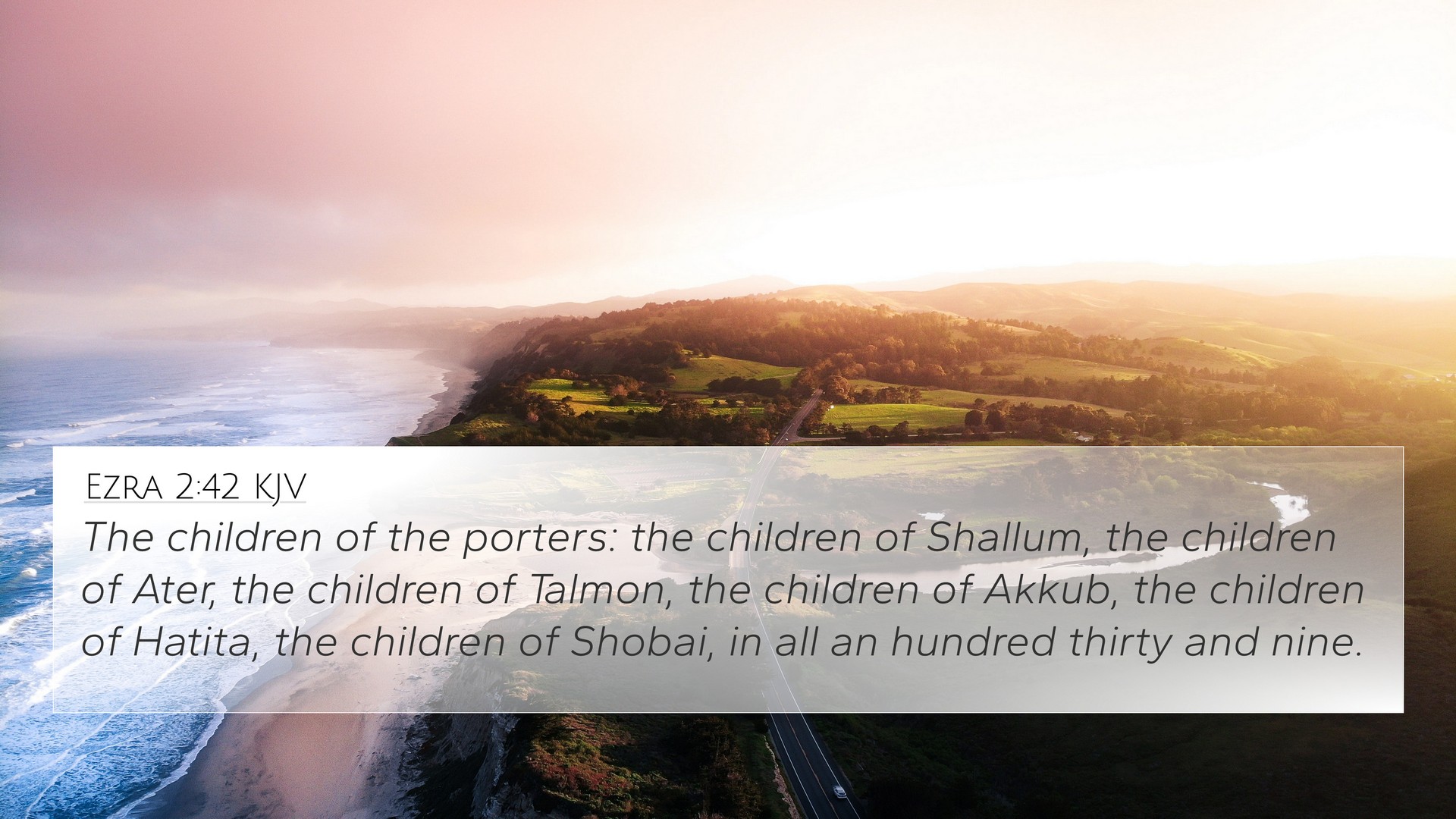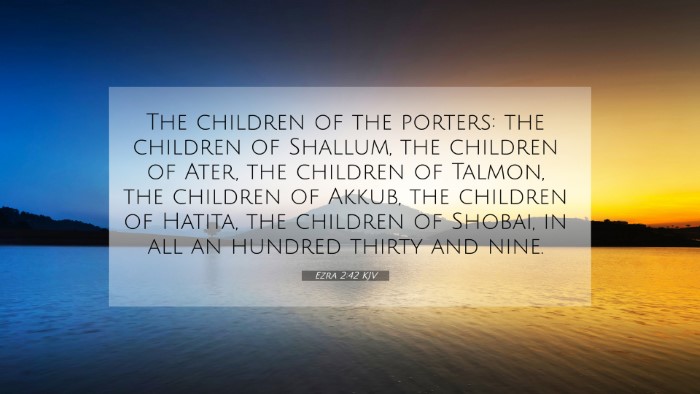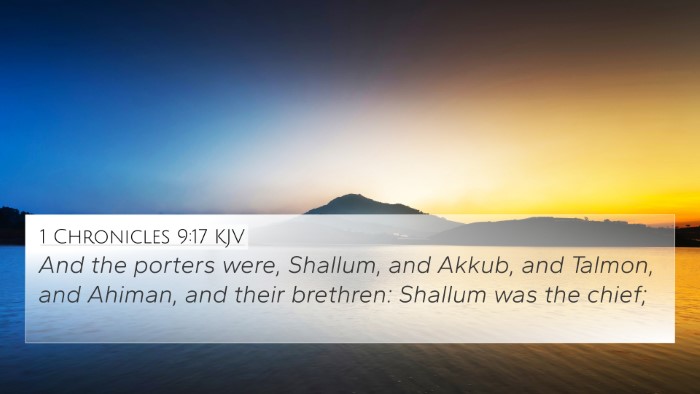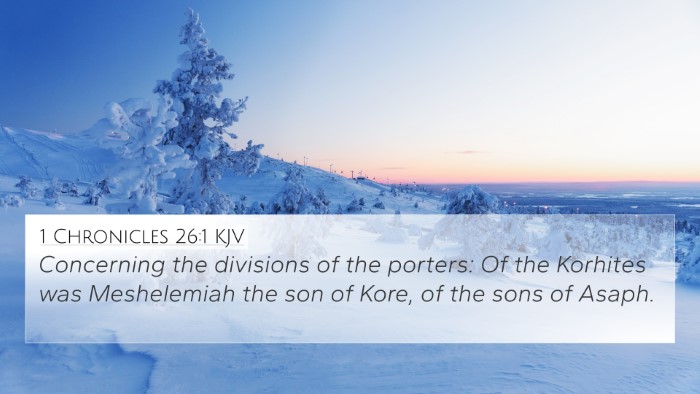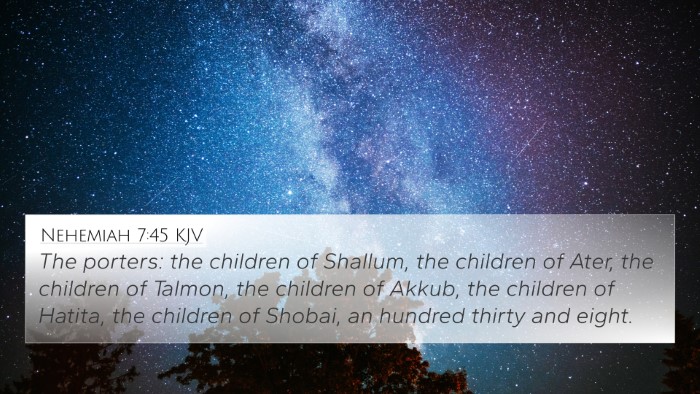Understanding Ezra 2:42
Ezra 2:42 states, “The children of the gatekeepers, the children of Shallum, the children of Ater, the children of Talmon, the children of Akkub, the children of Hatita, the children of Shobai, in all 139.” This verse specifically lists the descendants of the gatekeepers who returned to Jerusalem from Babylonian captivity. Each name reflects not only the heritage of the people but also their role and significance in the rebuilding society.
Meaning and Context
This verse is part of a larger passage, where Ezra records the names and numbers of those who returned to Jerusalem after the exile. In analyzing Ezra 2:42, we can use various public domain commentaries to enrich our understanding:
- Matthew Henry: Henry emphasizes the importance of the gatekeepers in the temple. They held a vital position in safeguarding the house of God, symbolizing the need for vigilance and protection within the spiritual community.
- Albert Barnes: Barnes points out the significance of naming individuals in this context. Each name represents a family that played a role in the restoration of the Jewish community, reminding us of the communal effort required in rebuilding faith and identity.
- Adam Clarke: Clarke elaborates on the spiritual implications of the gatekeepers. He draws connections between their service and the spiritual oversight necessary for any congregation. This reflects the idea that every role in the church, no matter how seemingly minor, is crucial to the overall mission.
Bible Verse Cross-References
When studying Ezra 2:42, we find several other Bible verses that relate, providing a deeper insight into its message:
- 1 Chronicles 9:17-19: This passage discusses the gatekeepers of the temple, reaffirming their roles and responsibilities.
- Psalm 84:10: “For a day in Your courts is better than a thousand elsewhere.” This relates to the significance of the gatekeepers' role in maintaining access to the place of worship.
- Nehemiah 11:19: Continuing the theme of gatekeepers, this verse identifies their duties within the reestablished city.
- John 10:9: “I am the door; if anyone enters by Me, he will be saved.” This verse draws a Christological connection, presenting Jesus as the ultimate gatekeeper for access to salvation.
- Matthew 16:19: In this verse, Jesus gives Peter the keys to the Kingdom of Heaven, similarly reflecting the authority of gatekeepers.
- Revelation 21:12: The twelve gates of the New Jerusalem signify eternal access to God’s presence, mirroring the importance of physical gates.
- Ezra 10:24: Lists Levites, providing context on the necessary roles for temple service, emphasizing collective identity.
Thematic Connections
The themes in Ezra 2:42 connect to larger biblical narratives about identity, service, and commitment within God's people. The names listed do not merely convey individual identities but signify the collective return to worship and faithfulness.
Tools for Bible Cross-Referencing
When engaging in a deeper study of scriptures like Ezra 2:42, readers can utilize various tools:
- Bible concordance
- Bible cross-reference guide
- Cross-reference Bible study methods
- Bible reference resources
- Comprehensive Bible cross-reference materials
Interpreting the Biblical Message
Understanding Ezra 2:42 involves recognizing the communal and spiritual dimensions of each role listed. The gatekeepers were responsible for both physical security and spiritual guardianship, which speaks volumes about the nature of service in God's Kingdom.
Conclusion
This verse and its cross-references highlight the interconnectedness of biblical texts. They remind believers today that every role within the community of faith is crucial and that returning to God after exile involves both individual and collective action.
In conclusion, studying Ezra 2:42 can inspire individuals to appreciate their part within the body of Christ and understand how their unique gifts contribute to the broader mission of the church.
